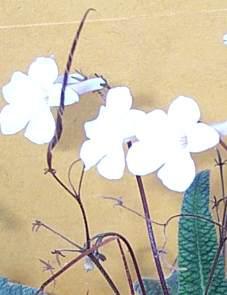Streptocarpus kentaniensis
Streptocarpus kentaniensis Britten & Story
Family: Gesneriaceae
Common names: Kentani streptocarpus
Introduction
Most striking about Streptocarpus kentaniensis is the abundance of small white flowers in mid-winter when no other Streptocarpus species are in flower.

Description
Description
Streptocarpus can be difficult to identify, but S.kentaniensis is unique in many ways. Even when not in flower the plant is easy to recognize with its long narrow and stiff, almost succulent leaves.
The long, narrow leaves are arranged in a very neat rosette, with the new leaves growing from the centre. On the underside, the midrib is very thick and prominent, while the smaller lateral veins form an intricate web as they run to the edge. The upper surface of the leaf is dark green and contrasts beautifully with the dark reddish brown flowering stems that shoot from the midrib at the base of the older leaves.

Every leaf has 3 to 5 flowering stems developing in succession. One leaf could have an old stem with seed capsules, a stem with flowers almost finished, a stem with flowers and buds while two more stems are developing in front of the older stems.
The flowering stems are about 100-150 mm long with the tips drooping while the flowers are still in bud. The flowering stems often branch to form a few flowers on each stem. The leaves, flowering stems and flowers are covered in short, white hairs. The individual flowers are small but very pretty. The flower is bi-coloured with a long, mauve tube which opens into five, rounded, white petals, two at the top and three at the bottom. Looking down the throat of the tube one can see dark mauve lines and a light yellow line running along the floor.
Compared to the size of the flowers (20-25 mm wide by 25-30 mm long), the seed capsules are very long (60-70 mm), and are twisted.

Conservation Status
Status
According to the website http://redlist.sanbi.org, checked on 9 November 2015, Streptocarpus kentaniensis is Vulnerable (VU). It's population is stable but it is known from only three locations, and its habitat may become degraded because the surrounding area is being deforested by subsistence farming practices.
Distribution and habitat
Distribution description
The distribution of this species is limited to the area around Kentani and the Kei River mouth in the former Transkei. In the forests, Streptocarpus kentaniensis grows naturally on south-facing rock walls with its roots wedged into crevices or on rock ledges, usually in association with other plants like Crassula, Sansevieria, Dietes and Peperomia.
Derivation of name and historical aspects
History
Typical for Streptocarpus, the seed capsule is twisted, unfolding and opening as it dries to release the very fine seeds when ripe. This characteristic gives the genus its name, from the Greek streptos meaning twisted and carpus meaning fruit. The species name kentaniensis refers to the village of Kentani in Eastern Cape, where it was first collected.
Streptocarpus belongs to the same family (Gesneriaceae) as the well-known African violets that are grown as pot plants all over the world. While the African violets or Saintpaulia species occur naturally in Tanzania close to the equator, most of the Streptocarpus species that occur in Africa — 51 of the 135 species — occur in southern Africa.
Ecology
Ecology
Seeds are small and light and are dispersed by wind.
Uses
Use
Streptocarpus streptocarpus is a well-known pot plant in the horticultural market. S. kentaniensis is relatively new to the market, and its unsusual winter flowering time may make it a sought-after parent to extend the flowering time of the garden hybrids.
Growing Streptocarpus kentaniensis
Grow
Streptocarpus kentaniensis makes a lovely small pot plant, suitable for a shady place in the garden and for indoors. A warm spot with plenty of light but no direct sun is ideal for growing the plants. It is very important that all Streptocarpus are potted in a well-drained medium and not over-watered. Rather let the potting mix dry before giving the next watering, as the plants will wilt and rot with over-watering. When the plants are stressed by drought or cold during the winter, the tips of the leaves will sometimes turn brown and dry. The dead tips may look a bit untidy but do not harm the plant, they leaves will continue to grow from the base.
Streptocarpus kentaniensis is easy to multiply simply by dividing a group, carefully separating a few leaves or an individual leaf with its roots attached and repotting it. Streptocarpus can also be propagated from seed or leaf cuttings. Thousands of fine brown seeds are released a month or two after flowering. The seeds usually germinate quite easily and fast when sown on a fine potting mix that is kept moist and warm. The seedlings can be potted when they are large enough to handle.
The leaf cuttings are made by cutting the leaf across the midrib, dipping the cut edge into rooting hormone and then placing it into a well-drained medium, like clean sand. New roots will form at the cut edge, followed by new leaves. The potting medium for growing strong and healthy Streptocarpus is very important. At Kirstenbosch we use well-decomposed compost with a small amount of slow release fertilizer added.
Credits
Liesl van der Walt
Kirstenbosch National Botanical Garden
July 2002
Plant Attributes:
Plant Type: Perennial
SA Distribution: Eastern Cape
Soil type: Loam
Flowering season: Winter
PH: Neutral
Flower colour: White, Mauve/Lilac
Aspect: Shade
Gardening skill: Average
Special Features:
Horticultural zones








Rate this article
Article well written and informative
Rate this plant
Is this an interesting plant?
Login to add your Comment
Back to topNot registered yet? Click here to register.